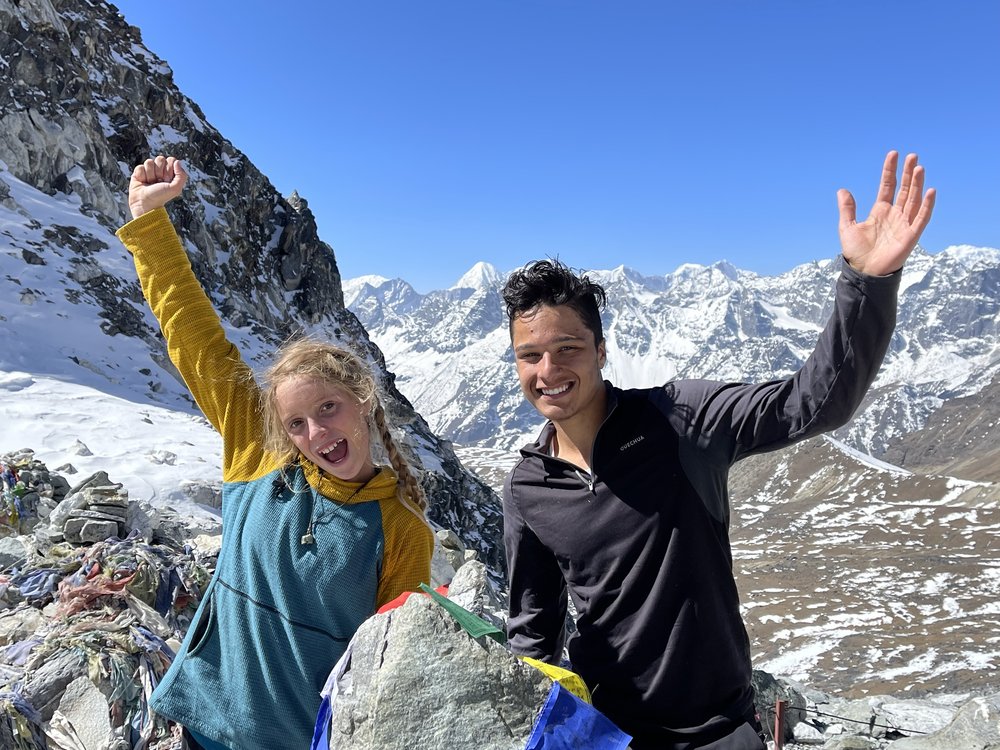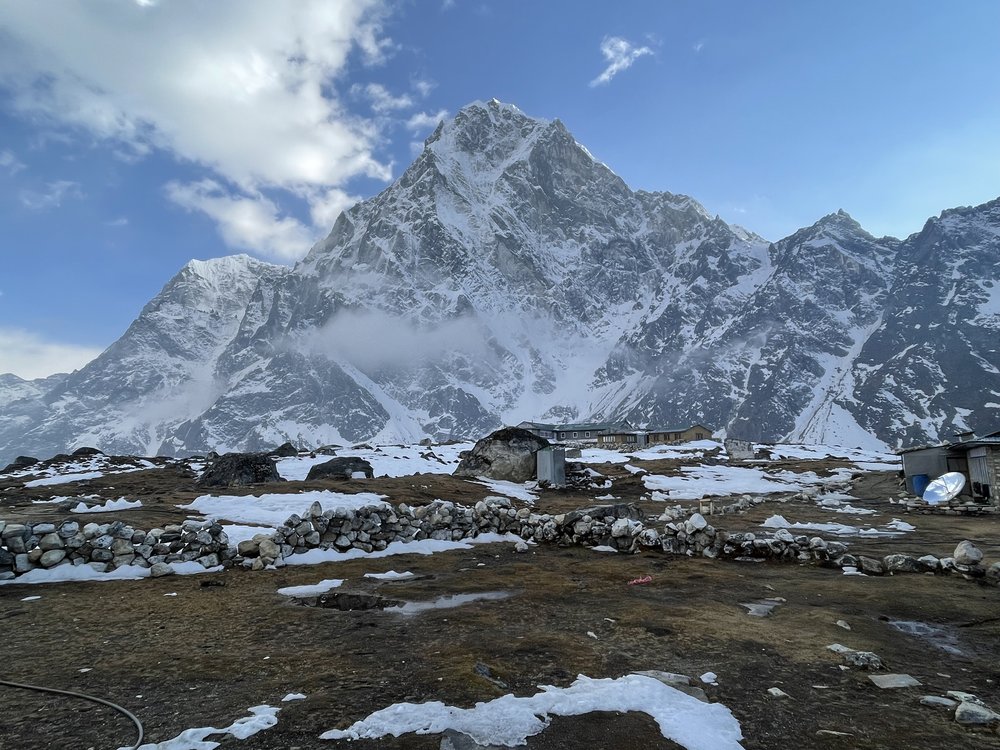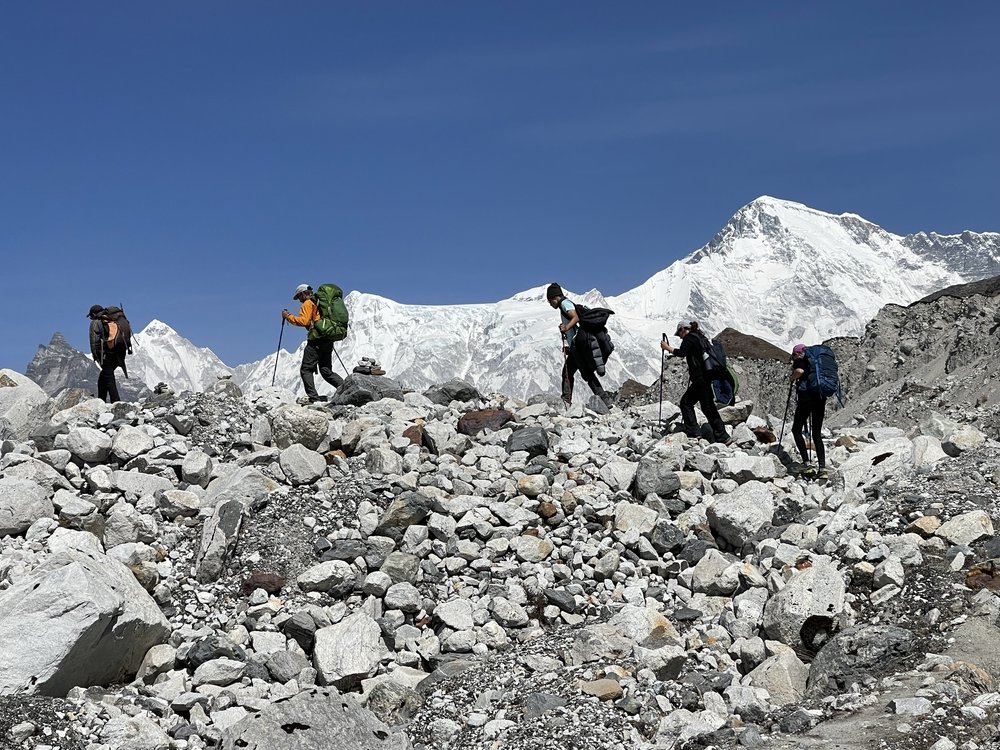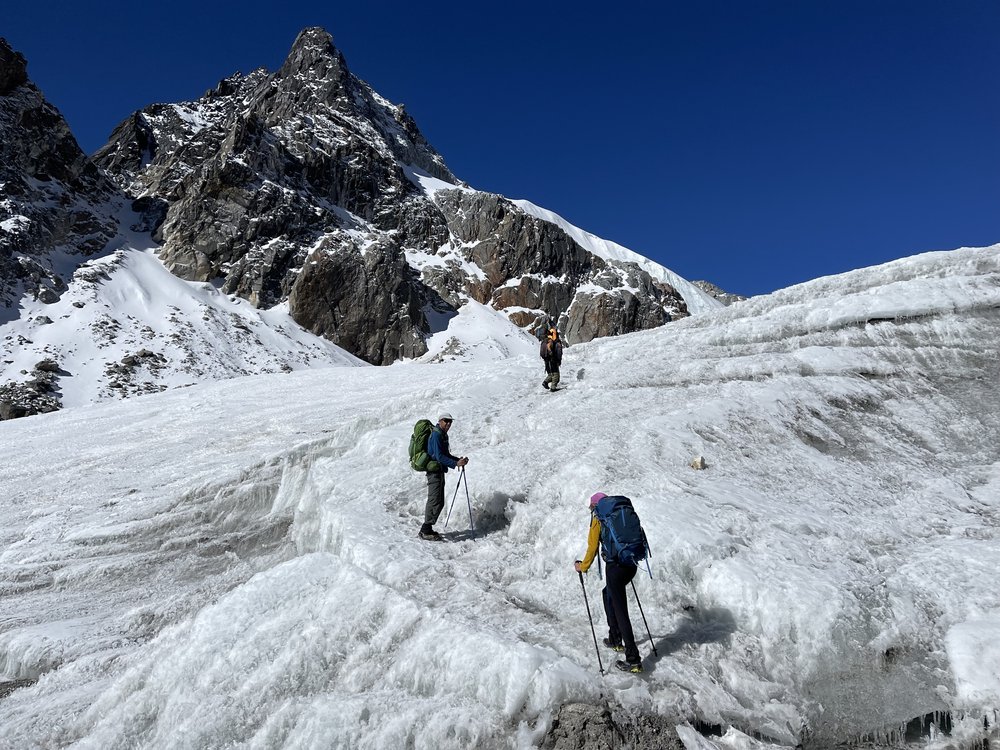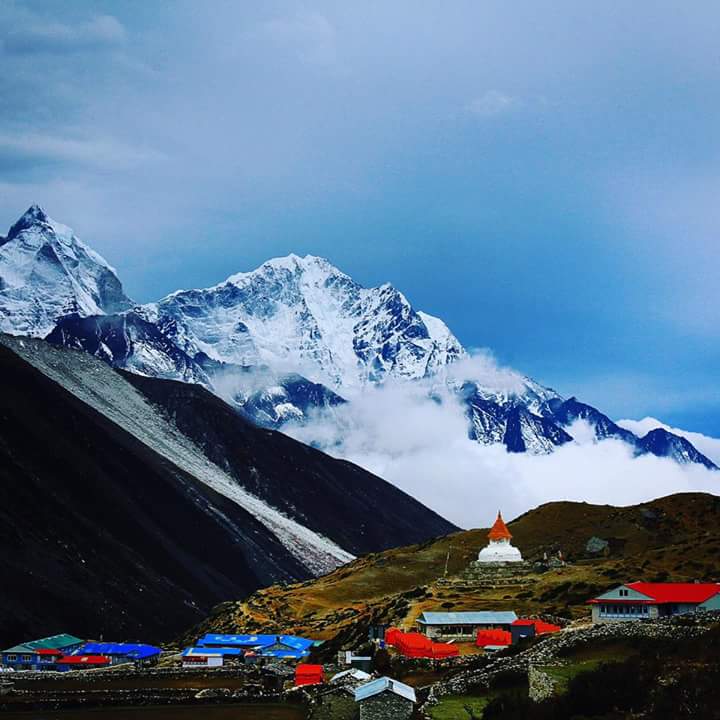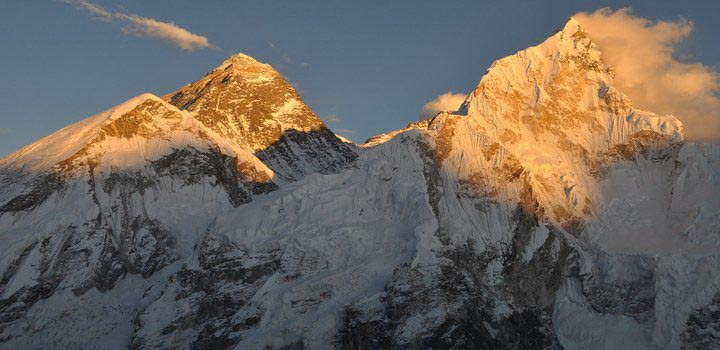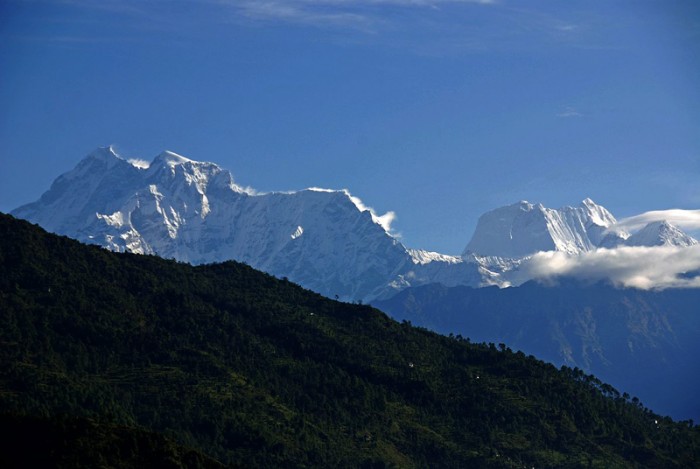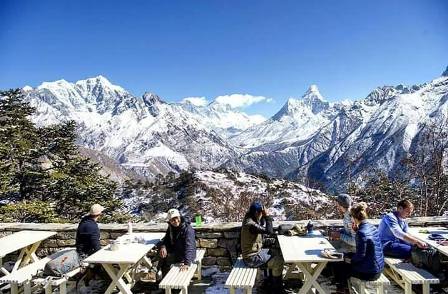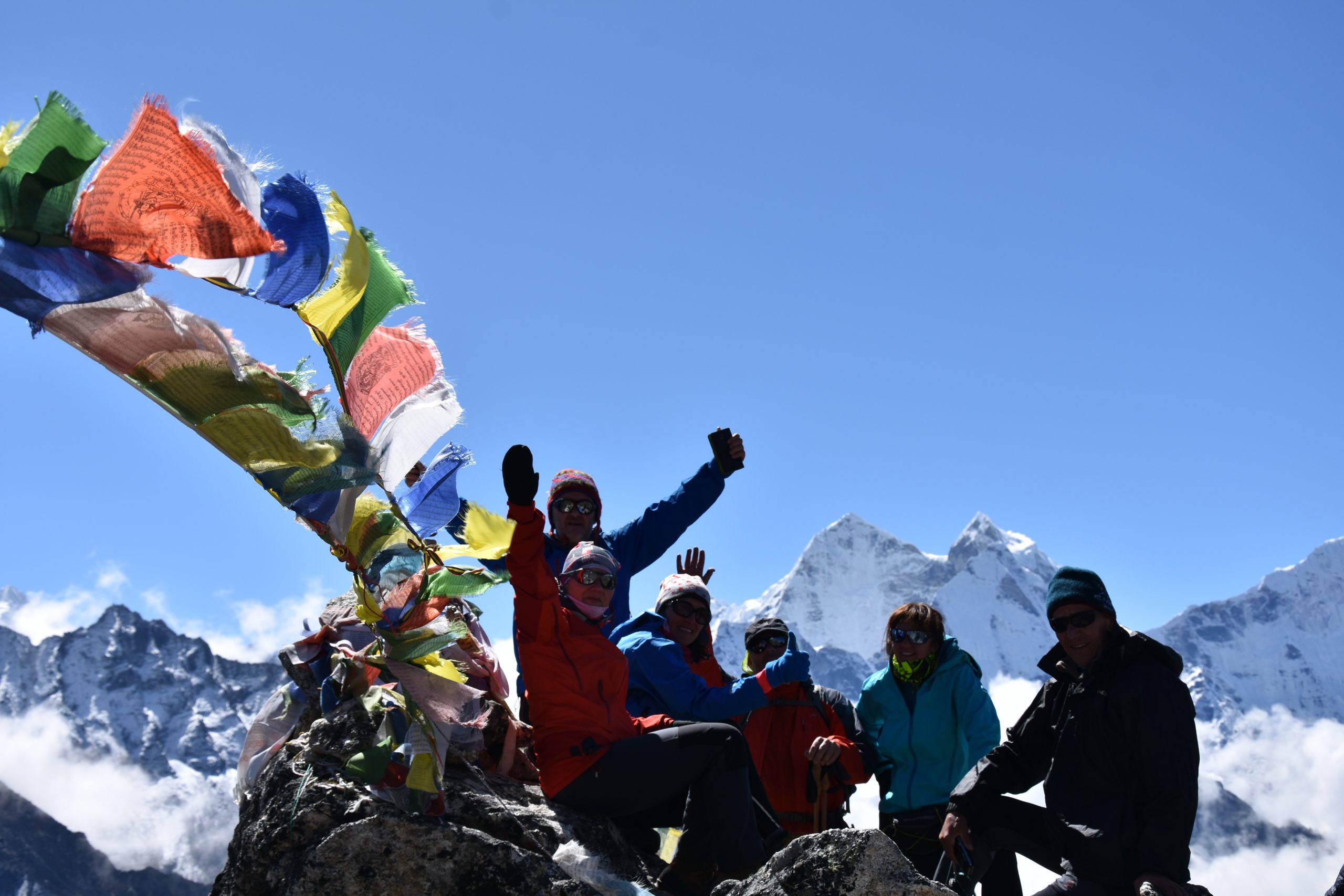Everest Base Camp with Chola Pass via Gokyo Lake
Everest Base Camp Trek, with Chola Pass Trek via Gokyo Lakes, takes us through the landmarks of the Khumbu region. The Everest Base Camp Trek via Gokyo Lakes is an amazing journey that offers a unique opportunity to explore the stunning views of Gokyo and the famous Chola Pass. The Gokyo Lake, located at a high elevation, is a wild and beautiful place surrounded by the magnificent peaks of Cho Oyu (8153m) and Gyachung Kang (7922m). Trekking to Gokyo Lake in the Khumbu Everest region is like entering a bit of heaven. The trek offers a once-in-a-lifetime experience with breathtaking views of Mount Cho Oyu, Everest, Lhotse, Makalu, Nuptse, and other peaks. The largest Tengboche Monastery in the Khumbu region is also an impressive sight to see. In 2015, Lonely Planet recommended the Khumbu region – Gokyo Everest Trek as one of the best trekking trails to explore.
Gokyo Valley Trek with Chola Pass and the Everest Base Camp is also an incredible trek. It crosses all the high valleys of Khumbu with additional time spent at the Gokyo Lake to explore the upper valley.
Day 01: Arrival in Kathmandu (1,350m/4,428ft)
Day 02: Kathmandu Sightseeing and Trek Preparation
Day 03: Fly to Lukla, trek to Phakding (2,651m/8,700ft): 3 – 4 hours trek
Day 04: Phakding to Namche Bazaar (3,438m/11,280 ft): 5 – 6 hours
Day 05: Acclimatization Day – Namche Bazaar: (3,440m/11,284ft)
Day 06: Namche Bazaar to Phortse Thanga (3,680m/12,073ft): 5-6 hours
Day 07: Phortse Thanga to Machhermo (4,470m/ 14,663ft): 4-5 hours
Day 08: Machhermo to Gokyo (4,800 m/15,744 ft): 4-5 hours
Day 09: Explore Gokyo Valley
Day 10: Gokyo to Thagnak (4750 m/15,580 ft): 4 – 5 hours
Day 11: Thagnak to Cho La pass (5,367m/17,604 ft) to Dzongla (15, 939 ft): 7 – 8 hours
Day 12: Dzongla to Lobuche (4940 m/16,207 ft): 2 – 3 hours
Day 13: Lobuche to Gorak Shep (5,170 m/16,961ft), visit Everest Base Camp (5,364 m/17,594 ft): 6-7 hours
Day 14: Gorak Shep to Kala Patthar (5368 m / 17611 ft) to Pherice (4,288m/14,070ft) 7-8 hours
Day 15: Pheriche to Namche Bazaar: 6 – 7 hours
Day 16: Namche Bazaar to Lukla (2,800m/9,186ft): 6 – 7 hours
Day 17: Fly to Kathmandu
Day 18: Departure Day
Day 01: Kathmandu Arrival (1,350m/4,428ft)
Upon your Arrival in Kathmandu, you are welcomed by one of our representatives, and you are transferred to your hotel. Overnight at your hotel in Kathmandu.
Day 02: Kathmandu Sightseeing and Trek Preparation
A full day of Kathmandu sightseeing begins. Kathmandu is the cultural heart of Nepal and a popular destination for travelers. The city is a good blend of Hinduism, Tibetan Buddhism, and Western influence cultures within the Valley. The cultural heritage of Kathmandu Valley displays the realness and richness of art, culture, and crafts. Visit the Patan Durbar Square, Swayambhunath Stupa (Monkey Temple), Pashupatinath Temple, and Boudhanath Stupa. Stay overnight at the Hotel.
Included Meals: Breakfast
Day 03: Kathmandu – Lukla – Phakding (2,651m/8,700ft): 40 minutes flight, 3 – 4hrs
An early morning Lukla flight for about 40 minutes. Enjoy the breathtaking views from the plane. Upon reaching Lukla, meet the rest of the crew members. Join them and commence the trek towards Phakding via Cheplung village. Overnight at Phakding.
Included meals: Breakfast, Lunch, and Dinner
Day 04: Phakding – Namche (3,438m/11,280 ft): 5 – 6 hrs
A trek to Namche begins and walks through the trail and reaches the Benkar Valley. Pass through Chumoa and Monjo villages after crossing the Dudh Koshi River. Cross a suspension bridge to reach Jorsale and continue walking until Namche. Overnight in Namche Bazaar.
Included meals: Breakfast, Lunch, and Dinner
Day 05: Acclimatization Day – Namche Bazaar (3,440m/11,284ft)
An acclimatization rest at Namche Bazaar to adjust to the thinning air. A hike to the Sagarmatha National Park which has diverse flora and fauna. A stunning view of Mt. Everest, Lhotse, Nuptse, Ama Dablam, and so on. Alternatively, hike to Khumjung village. Overnight in Namche Bazaar.
Included meals: Breakfast, Lunch, and Dinner
Day 06: Namche Bazaar to Phortse Thanga (3,680m/12,073ft): 5-6 hrs
Climb uphill to Khumjung and downhill towards the valley taking to the Dud Koshi River. On the way, get a sight of Chorten, sacred Mt. Khumbila, and keep descending until Phortse Thanga. Overnight in Phortse Tanga.
Included meals: Breakfast, Lunch, and Dinner
Day 07: Phortse Thanga to Machhermo (4,470m/ 14,663ft): 4-5 hrs
Walk through the trails surrounded by rhododendron forest. Witness a waterfall on the way and reach Tongba village. Proceed further and ascend uphill traversing the villages of Dhole, Labarma, and Luza, and finally arrive at Machhermo. Overnight in Machhermo.
Included meals: Breakfast, Lunch, and Dinner
Day 08: Machhermo to Gokyo (4,800 m/15,744 ft): 4-5 hours
Walk through the trails of Phangkha and descend to the riverbank. Slowly climb over a steep moraine of the Ngozumpa Glacier and traverse a bridge. Continue following the path and pass Gokyo Lake I, II, and III and arrive at Gokyo village with Mt. Cho Oyu in the background. Later, explore the third lake and overnight in Gokyo village.
Included meals: Breakfast, Lunch, and Dinner
Day 09: Gokyo Valley: Acclimatization
A rest day in the Gokyo Valley for acclimatization to adjust to the altitude. Some options are there to hike and explore. A hike to Gokyo Ri to enjoy the wonderful views of mountain vistas and the Gokyo valley. Else, a hike to the Gokyo 4th Lake and 5th Lake and get amusement with the serene beauty of the lake. Also, hike to Scoundrel’s Viewpoint from the edge of 5th Lake. Witness some majestic views of Everest, Lhotse, Nuptse, Cho Oyu, Makalu mountains, and the largest Ngozumpa Glacier. Trek back to Gokyo and spend the night.
Included meals: Breakfast, Lunch, and Dinner
Day 10: Gokyo to Thagnak (4750 m/15,580 ft): 4 – 5 hours
Walk traversing along the edge of the mountains and adore the surrounding scenery. Arrive at Thagnak and stay overnight.
Included meals: Breakfast, Lunch, and Dinner
Day 11: Thagnak via Cho La pass (5,367m/17,604 ft) to Dzongla (15, 939 ft): 7 – 8 hours
A long yet fruitful trek via Cho La Pass from Thagnak to Dzongla. Climb carefully towards Cho La Pass as the trail is steep and have to traverse through some glaciers. The sight of prayer flags reaching the top and spectacular views of Ama Dablam, Lobuche, and Baruntse are so close. Descend slowly and continue further to reach Dzongla. Overnight in Dzongla.
Included meals: Breakfast, Lunch, and Dinner
Day 12: Dzongla to Lobuche (4940 m/16,207 ft): 2 – 3 hours
A short trek to Dzongla enjoying the surrounding beauty and walking on a grassy trail. Get a glimpse of Lobuche Peak en route. Arrive at Lobuche and take a rest and prepare for the next day’s long trek. Overnight in Lobuche.
Included meals: Breakfast, Lunch, and Dinner
Day 13: Lobuche to Gorak Shep (5,170 m/16,961ft), visit Everest Base Camp (5,364 m/17,594 ft): 6-7 hours
A long trek commences from Lobuche to Everest Base Camp. Stop at Gorak Shep for lunch and continue further to the base camp. Passing through glacial moraines and following the guide’s instructions carefully reach the base camp. Enjoy the close-up views of Mt. Nuptse, Lhotse, Pumori, and others from the Everest Base Camp. A dream to trek to the Everest Base Camp is finally accomplished. Spend some time there and return to Gorak Shep for an overnight stay.
Included meals: Breakfast, Lunch, and Dinner
Day 14: Gorak Shep to Kala Patthar (5,545m/18,192ft) to Pheriche (4,288m/14,070ft) 7-8 hours
An early morning trek towards Kala Patthar around 3 am. Kala Patthar is the perfect destination to get an awesome sunrise view over Mt. Everest and panoramic mountain vistas. Upon reaching Kala Patthar, enjoy the close-up views of Lingtren, Khumbutse, Nuptse, Lhotse, Mt. Everest, and other mountains. Take some snaps and return to Gorak Shep. Have lunch over there and descend to Pheriche for an overnight stay.
Included meals: Breakfast, Lunch, and Dinner
Day 15: Pheriche to Namche Bazaar: 6 – 7 hours
Walk through the hillside surrounded by trees of juniper and rhododendron. Follow the Dudh Koshi Gorge after crossing a bridge and descending through the pine forest. Enjoy the views of Nuptse, Ama Dablam, and Thamserku mountains and reach Namche Bazaar. Overnight in Namche Bazaar.
Included meals: Breakfast, Lunch, and Dinner
Day 16: Namche Bazaar to Lukla (2,800m/9,186ft): 6 – 7 hours
Walk on a steep downward trail and traverse a suspension bridge over the Dudh Koshi River. Arrive at Lukla and spend last night in the lap of mountains. Take complete rest and enjoy the night by celebrating and eating food and drinks. Overnight in Lukla.
Included meals: Breakfast, Lunch, and Dinner
Day 17: Lukla – Kathmandu 1400 m
An early morning flight to Kathmandu after accomplishing the long trek. Rest and enjoy the day completely in Kathmandu. Relax at a hotel and later join us for a cultural dinner. Overnight in Kathmandu.
Included meals: Breakfast
Day 18: Departure Day
Our driver transfers you to the airport for final departure to connect your international flight. Have a safe journey.
Included meals: Breakfast
Note: To avoid the risk of missing your flight back home we always suggest you have 2 to 3 days extra at the end of your trip because the flight from Kathmandu -Lukla -Kathmandu airport is sometimes delayed or canceled due to bad weather conditions.
If the flight to Lukla is canceled for more than 3 days, then in that case we will possibly change the itinerary for something equally better alternative trek. If you are not interested in the alternative trip and would rather wait for your original preferred trip, you are welcome to wait in Kathmandu for as many days as it takes to get a flight to Lukla. We also recommend you do travel Insurance that covers Helicopter rides or flight delay/cancellation issues.
What’s Included
- Airport pickups and drops by private vehicle
- 3- Star category hotel in Kathmandu with breakfast
- Teahouse/Lodge accommodation including Breakfast, Lunch, and Dinner during the trek
- Farewell dinner at the end of the trip
- Domestic flights (Kathmandu- Lukla -Kathmandu)
- Sightseeing in Kathmandu (4 – 6 hr)
- An experienced, English-speaking, and government-licensed trekking guide.
- Porter service (2 trekkers: 1 porter)
- Staff costs including their salary, insurance, equipment, domestic airfare, food and, accommodation
- All necessary paperwork and trekking permits (National Park Permit, TIMS)
- Medical kit (carried by your trek leader)
- All government and local taxes
What’s Excluded
- Nepalese visa fee
- Excess baggage charge(s)
- Tour Guide and Entrance Fees for Sightseeing in Kathmandu
- Extra night accommodation in Kathmandu because of early arrival, late departure, or early return from the mountain (due to any reason) than the scheduled itinerary
- Lunch and Dinner in Kathmandu
- International flights
- Travel and rescue insurance
- Personal expenses (phone calls, laundry, Bar bills, battery recharge, extra porters, bottle or boiled water, Tea, Coffee, Alcoholic drinks, hot and Cold drinks, WiFi, hot shower, etc.)
- Tips for guide(s), porter(s) and driver(s)
The following gives you a general idea of the personal items that you need to bring for the trek. The personal items are of individual interest and choice. The most important fact that one should keep in mind is that one should have enough clothes to tackle the cold weather in the Himalayas.
Upper Body – Head / Ears / Eyes
- Sun hat (We provide you a complimentary sunhat)
- Wool or synthetic hat that covers the ears
- Sunglasses with UV protection
- Headlamp
- Neck warmer
Hand
- Liner gloves
- Heavier shell gloves
Core Body
- T-shirts (2)
- Lightweight expedition thermal tops
- Fleece jacket or pullover
- Water/windproof shell jacket (Preferably breathable fabric)
- Synthetic sports bras (for women)
Lower Body – Legs
- Lightweight expedition thermal bottoms
- Nylon hiking shorts
- Soft shell and hard shell trekking pants
- Water/windproof trousers
- Casual pants
Feet
- Liner socks
- Heavyweight socks
- Waterproof hiking/trekking boots
- Light shoes/sneakers
- Gaiters (For monsoon and winter)
Other essential important items
- Passport and extra passport photos (2 copies)
- Airline tickets (Please make a copy and leave one at our office in KTM just in case you need to change the date of yours)
- Durable wallet/pouch for travel documents, money & passport
- Water bottle/bladder
- Water purification Iodine tablets
- Toiletries (Include toilet paper, wet wipes, and liquid hand sanitizer, towel, soap)
Medicines and First Aid Kit
- Extra Strength Excedrin for altitude-related headaches
- Ibuprofen for general aches and pains
- Immodium or Pepto bismol capsules for upset stomach or diarrhea
- Diamox (commonly prescribed as Acetazolamide) 125 or 250mg tablets for altitude sickness
- Anti-infection ointments
- Band-aids
- Lip balm (At least SPF 20)
- Sunscreen (SPF 40)
Optional
- Adjustable trekking poles
- Favorite snacks (No more than 2 pounds)
- Paperback books, cards, mp3 player.
- Binoculars
- Backup, Cameras (Memory cards, chargers, and batteries)
- Pee bottle for man and pee funnel for woman
Note: This equipment list is only a guide. You need to bring the listed items, however, you can choose from your preferred brands using your expertise. Plus, you can shop the trekking equipment and clothing at a reasonable price at stores in Thamel, Kathmandu.
1. Will somebody come to pick me up?
A representative from Himalayan Sanctuary Adventure will pick you up from Tribhuvan International Airport in Kathmandu .
2. What sort of accommodation can I expect in trekking?
Normal Teahouses/lodges will be provided along the trekking routes in the mountains. The lodges in trekking routes usually provide single and double rooms. At times when possible, dining will be around a bonfire. In tea houses, food will be prepared in the kitchen which you should not enter without permission. somewhere until Dingboche, you will have an attached toilet and bathroom. But in two locations Lobuche and Gorakshep, you will have to use a common toilet and bathroom. (depend on the Season)
3. Is it possible to swap my accommodation from a mountain guesthouse to a hotel in Kathmandu?
Substituting the accommodation or swapping from the mountain guest house to Kathmandu is not possible. We only provide 3 nights’ accommodation in Kathmandu included in the package. In case of flight cancellation or early arrival to Kathmandu due to any sickness in the mountain or any of your reason or due to bad weather and you are unable to continue the trek, you will need an extra night accommodation/s in Kathmandu. We can make these arrangements for a supplemental charge.
4. Is it possible to reserve a trip now and pay a deposit later or do I Have to pay a deposit at booking/reservation?
Yes! The trip will be confirmed only when we receive the completed final booking form and a 30% deposit payment. You can pay the balance of the money when you arrive in Kathmandu.
5. Is there a possibility of getting separate rooms for the trip?
During the trek, we will try our best but normally the lodges have twin-sharing and dormitory-styled rooms instead of a single room.
6. Is this a guaranteed departure even if I am alone starting in the requested trip?
Yes, all our trips are guaranteed to run. We never cancel the trip due to not having enough participants, we can arrange the trip for one person as well.
7. When I pay the remainder of the money on arrival in Kathmandu, how do you take that money? US cash or credit card?
You can clear the remainder of the money upon your arrival in Kathmandu or even before you arrive in Kathmandu. You can use USD, Euro, Pound, Canadian Dollar, Swiss franc in cash, Master, or Visa cards for the payment options. There will be a 4% bank levy when paying by credit card.
8. What sort of food can I expect in trekking?
Most teahouses (lodges) in Everest Base Camp trails cook a delicious range of mostly vegetarian fare. Pasta, tuna bakes, noodles, potatoes, eggs, daal Bhat (rice and lentils), bread, soup, fresh vegetables (variety depends on the season), and even some desserts like apple pies, pancakes, and some interesting attempts at custard. You will find a lot of garlic on the menu because it assists with acclimatization – eat some every day. In many larger villages, you may find some meat items on the menu. You can always get hot chocolate, tea, and hot lemon drinks, as well as soft drinks, and treats like chocolate and crisps. Each day dinner and breakfast will be at a lodge you’ll stay at while lunch will be taken on the way to the destination
9. Is the food in the mountain prepared to international standards in terms of safety?
YES, the food is very safe during the trekking but we recommend you to eat vegetarian and local food. Please follow the suggestion of our guide on the trek.
Bottled water is easily available at the lodges and tea houses. You can buy bottled water at the cost of USD 2 at lower elevations to USD 4 to higher elevations per littler. You can also drink the normal tap or spring water if you bring the purifying aid with you.
Sometimes, flights (to and from Lukla) may be canceled due to mountain weather conditions or technical issues. In such a case, Himalaya Sanctuary Adventure can help you charter a helicopter to ensure you are on schedule for your trek or international flight. The helicopter can fly if the visibility is 1500m, while the twin otter and Dornier can fly if the visibility is 5000m, as per Nepal’s Civil Aviation rules. If the weather is extreme and the visibility is lesser than 1,500m helicopters are also not operated for the flights. In such cases, we will reschedule your flight for the next day providing you with alternative trek options.
YES, you can obtain a visa easily upon your arrival at Tribhuvan International Airport in Kathmandu. A tourist Visa with Multiple Entries for 30 days can be obtained by paying US $ 40 or equivalent foreign currency. Similarly, a Tourist Visa with Multiple Entries for 90 days can be obtained by paying US $ 100. Please bring 2 copies of passport-size photos.
Where do we go to the toilet along the trail?
Wherever possible we utilize the toilet facilities provided by the tea houses/lodges on the trail. However, in case of emergency trekkers are recommended to find a private, scenic spot!
What are the Toilet facilities in the tea house/guesthouse?
Most of the tea houses do have western-style flushing toilets however tea houses at higher elevations you could find the squat toilets made of either a ceramic basin on the ground or a few planks precariously positioned over a hole in the ground which is always outside.
Is there a possibility of getting separate rooms for the trip? If so how much extra will this cost?
Normally the lodges have twin-sharing and dormitory-styled rooms. The lodges will provide a private room for one person when available.
In Kathmandu, USD 45 Per Room per Night would be added as a single supplement fee. The single supplements are always guaranteed in Kathmandu but not in the mountains especially during the peak time.
| Start Date | End Date | Price in USD | Availability | Booking | Note |
|---|
Avabillity Options
OPEN: This date is available and open for bookings. Go for it!
GUARANTEED: Guaranteed departure. Seat Available.
LIMITED: Guaranteed departure, Limited seat. You can send booking request for availability.
FULL:This date is currently unavailable. Please contact us if you are interested in traveling on this date.


